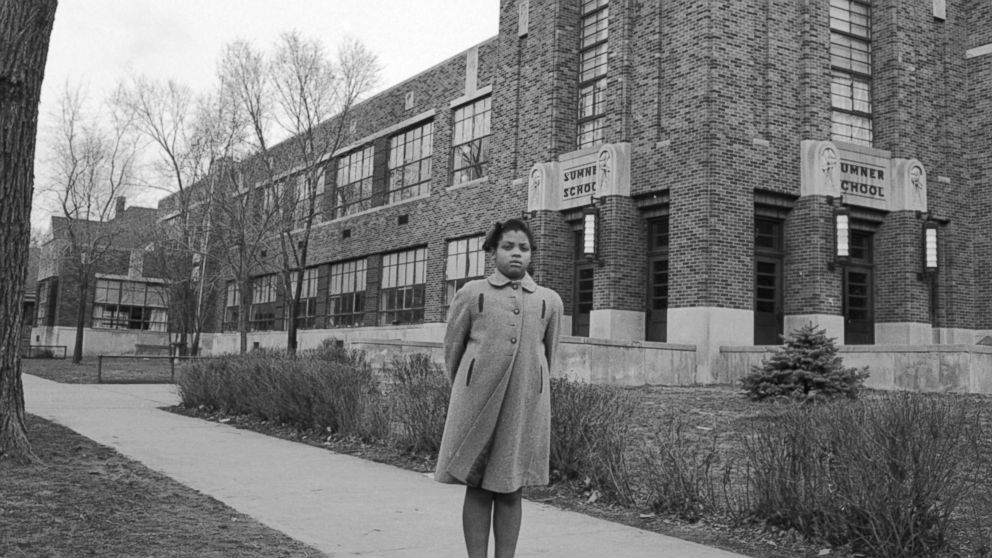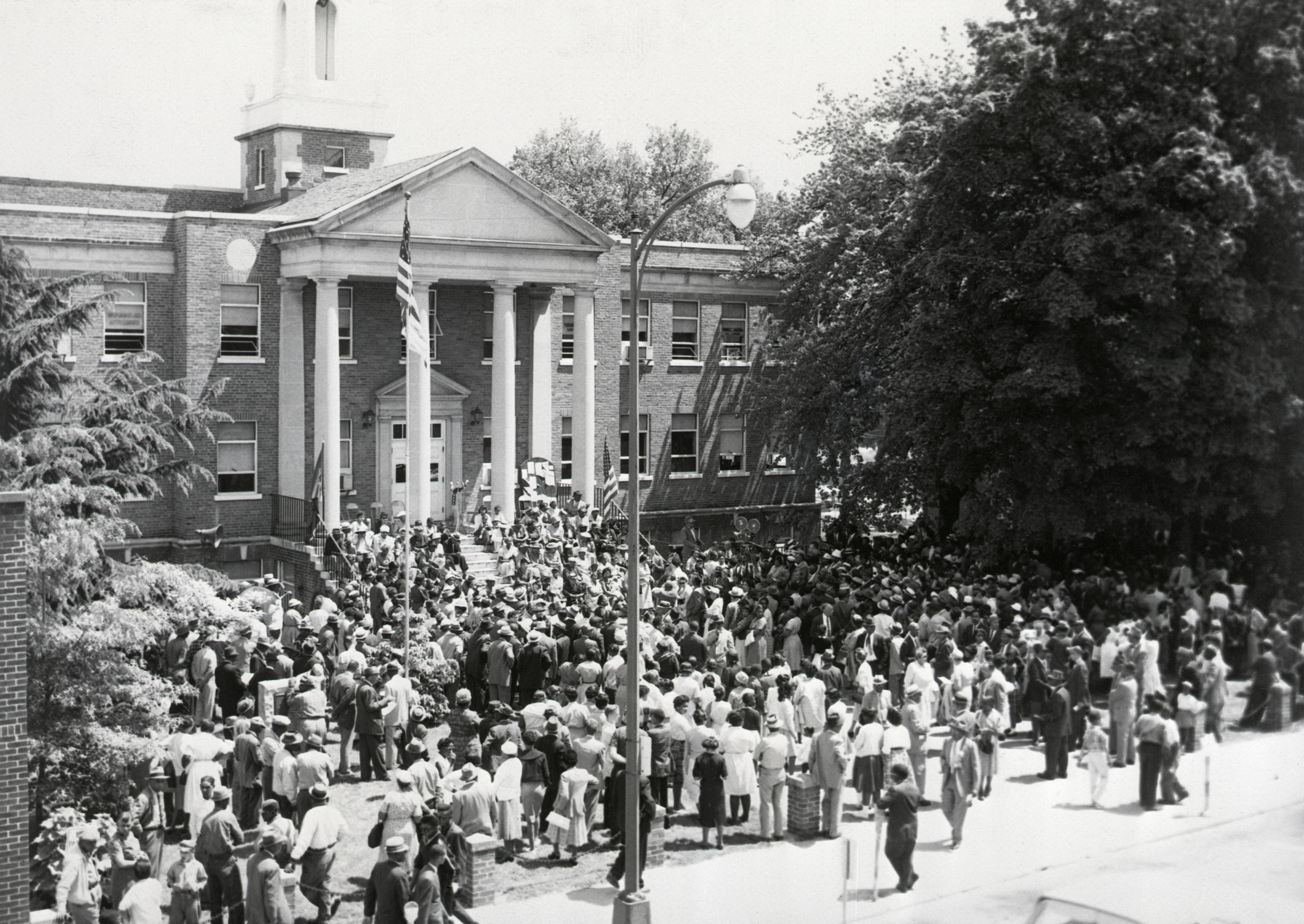In 1950 the state capital Topeka operated four elementary schools for black children. Based on an 1879 law the Board of Education in Topeka Kansas operated separate elementary schools for white and African-American students in communities with more than 15000 residents.
 Brown V Board Of Education Of Topeka Definition Facts Significance Britannica
Brown V Board Of Education Of Topeka Definition Facts Significance Britannica
Compliance coordinators may be contacted at 624 SW 24th Street Topeka KS 66611-1294 785 295-3000The clerk of the Board of Education has been designated to receive and redirect or handle inquiries regarding nondiscrimination policies regulations and procedures.

Topeka board of education. It ended the doctrine of separate but equal and brought an en. This is an abridged version of the document Brown v. By the end of World War II dramatic changes in American race relations were already underway.
The Board is composed of seven members elected to four-year terms. Six members are elected from three geographic districts two from each and one is elected to an at-large position. 483 1954 were first argued in the Supreme Court of the United States in December 1952.
Brown tegen Board of Education of Topeka 347 US 483 1954 was een baanbrekend besluit van het Amerikaanse Hooggerechtshof waarin het Hof oordeelde dat Amerikaanse staatswetten die rassenscheiding op openbare scholen vastleggen ongrondwettelijk zijn zelfs als de gescheiden scholen anders zijn gelijk in kwaliteit. Chief Justice Earl Warren wrote the opinion for Brown v. Board of Education was een rechtszaak die werd uitgevochten voor het Hooggerechtshof van de Verenigde Staten in 1954.
Twenty years after Brown in 1974 the Topeka school system USD 501 still underutilized predominately black schools while white schools remained overcrowded. Board of Education of Topeka was a landmark 1954 Supreme Court case in which the justices ruled unanimously that racial segregation of children in public schools was unconstitutional. A deep dive into Brown v.
The Supreme Court decided this case unanimously on May 17 1954. On June 8 1953 six months after the first arguments and nearly a year prior to the decision the Supreme Court ordered that the cases be re-argued in the October 1953 term 345 US. Board of Education of Topeka a Supreme Court case decided in 1954.
In 1954 the United States Supreme Court overturned that decision and. The Board of Education establishes educational policies to be carried out by the Superintendent of Schools. Supreme Court ruled unanimously 90 that racial segregation in public schools violated the Fourteenth Amendment to the Constitution which prohibits the states from denying equal protection of the laws to any person within their jurisdictions.
Board of Education of Topeka Kansas. School segregation was permitted by local option but only in elementary schools. The integration of labor unions in the 1930s under the eye of the Fair Employment Practices Commission and the desegregation of the armed forces by President Truman in 1948 marked major steps toward racial integration.
De rechters beslisten uiteindelijk dat de wettelijk vastgelegde rassenscheiding op openbare scholen niet mocht worden toegepast omdat er geen sprake van kon zijn dat zwarten onderwijs van hetzelfde niveau zouden krijgen als de blanken wanneer zij. Board of Education of Topeka I May 17 1954 Segregation of white and Negro children in the public schools of a State solely on the basis of race pursuant to state laws permitting or requiring such segregation denies to Negro children the equal protection of the laws guaranteed by the Fourteenth Amendment even though the. Brown et al.
She refilled the suit against the Topeka Board of Education in 1979 claiming African American children were still left out. The Board of Education of Topeka Kansas Slavery was never legally established in Kansas and racial separation there was less rigid than in the Deep South. Instead the Topeka School Board elected to build a third high school Topeka West at the western fringe of the growing city assigning to it 2 black children and 702 white children.
Linda Brown Smith said that in Topeka the civil rights legislation hadnt changed much. Board of Education was one of cornerstone of civil rights movements and helped establish the precedent that. The school segregation cases generally cited as Brown V.
Board of Education of Topeka Kansas a groundbreaking case that overturned the separate but equal standard set forth in Plessy v. Board of Education of Topeka case in which on May 17 1954 the US. The NAACP in Topeka sought to challenge this policy of segregation and recruited 13 Topeka parents to challenge the law on behalf of 20 children.
Board of Education of Topeka 1954 In 1896 the United States Supreme Court declared in Plessy v. Board of Education of Topeka. Board of Education of Topeka was a landmark 1954 supreme court case in which the justice ruled unanimously that racial segregation of children in public schools was unconstitutional.
Board of Education of Topeka 347 US. Ferguson that the doctrine of separate but equal was constitutional.
 Linda Brown Topeka Girl At Center Of Brown V Board Of Education Dies At 75 Abc News
Linda Brown Topeka Girl At Center Of Brown V Board Of Education Dies At 75 Abc News
 Brown V Board Of Education Summary Ruling History
Brown V Board Of Education Summary Ruling History
 Brown V Board Of Education Summary Ruling History
Brown V Board Of Education Summary Ruling History
 Visiting Brown V Board Of Education National Historic Site In Topeka Ks No Home Just Roam
Visiting Brown V Board Of Education National Historic Site In Topeka Ks No Home Just Roam
Brown V Board Of Education Of Topeka Kansas Brown V Board Of Education
Brown V Board Of Education Of Topeka An Account
 Visiting Brown V Board Of Education National Historic Site In Topeka Ks No Home Just Roam
Visiting Brown V Board Of Education National Historic Site In Topeka Ks No Home Just Roam
 Brown V Board Of Ed Anniversary Protecting A Court Decision Time
Brown V Board Of Ed Anniversary Protecting A Court Decision Time
 10 Things You Should Know About Brown V Board Of Education History
10 Things You Should Know About Brown V Board Of Education History